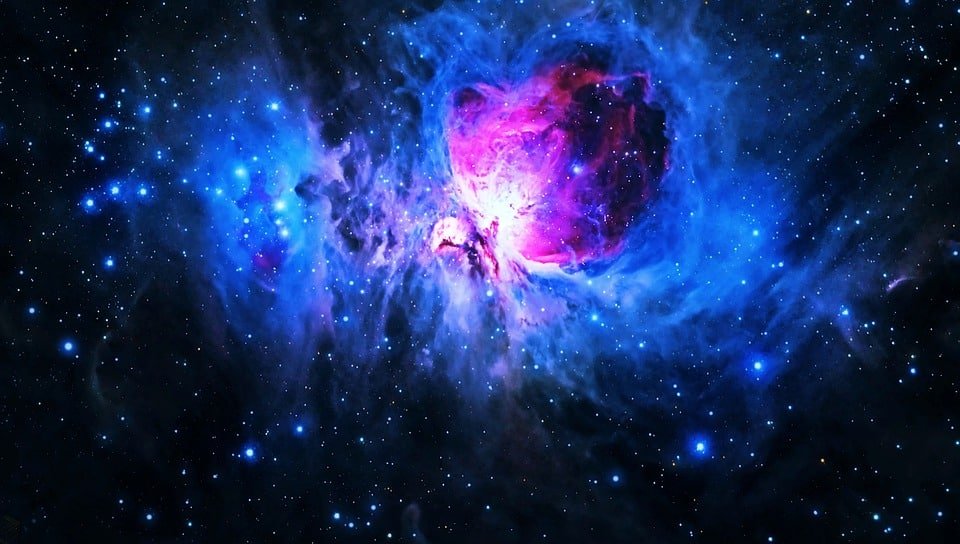Discover the fascinating discovery of a binary black hole system at the center of a distant galaxy. Learn how two supermassive black holes create periodic cosmic flares and what this breakthrough reveals about galaxy evolution and black hole behavior.
In March 2021, astronomers made an exciting and perplexing discovery: a strange signal emanating from the center of a faraway galaxy. Initially, researchers believed this phenomenon was the result of a supernova—a massive star explosion. However, as they observed the signal over time, something unusual became clear: the bursts of energy were occurring every 60 to 90 days. This predictable pattern ruled out the supernova theory and left scientists scrambling to determine the true source of the mysterious signal.
Exploring Phytoplankton Blooms in the Barents Sea: NASA’s Satellite Captures Rare Glimpse
By carefully analyzing this repeating pattern and gathering additional data, astronomers began to piece together the mystery. They combined observations from NASA’s Swift telescope with data from ground-based observatories to uncover an astonishing explanation: the signal was the result of two monster black holes orbiting one another, surrounded by a dense cloud of gas. The interactions between these black holes and the gas cloud were creating the flares observed in visible, ultraviolet, and X-ray light.
In this article, we’ll explore the details of this remarkable discovery, how scientists were able to track down the source of the signal, and why this finding could revolutionize our understanding of black holes and the behavior of galaxies at large.
The Mysterious Signal: A Discovery That Captivated Astronomers
The story began in March 2021 when astronomers detected a signal coming from a distant galaxy located millions, if not billions, of light years away. The signal appeared as periodic flares of light, which at first glance seemed to resemble the aftermath of a supernova—an explosive death of a massive star. Supernovae are known to release vast amounts of energy, causing massive bursts of light that can outshine entire galaxies.
However, the periodic nature of the flares—occurring every 60 to 90 days—made scientists question the supernova theory. A supernova is a one-time event, a single, dramatic explosion that fades over time. The fact that the flares were recurring on such a regular schedule suggested a different kind of phenomenon at work.
To get to the bottom of this mystery, scientists turned to a wide array of observational tools. The primary instrument they relied on was NASA’s Swift telescope, an observatory designed to detect and study cosmic explosions, including gamma-ray bursts, supernovae, and other transient events. Swift’s ability to observe a wide range of wavelengths—ranging from visible to X-ray light—was crucial for understanding the source of these mysterious signals.
The Role of NASA’s Swift Telescope
NASA’s Swift telescope was launched in 2004 and has since become one of the most important tools for studying high-energy astrophysical phenomena. Swift is equipped with three main instruments: a gamma-ray burst detector, an X-ray telescope, and an ultraviolet/optical telescope. These instruments allow astronomers to capture data across multiple wavelengths of light, providing a more complete picture of celestial events.
In this case, Swift’s observations revealed that the flares coming from the galaxy were not only regular but also emitted across a broad spectrum of light, including visible, ultraviolet, and X-ray wavelengths. This pattern of emission suggested that something other than a supernova or a single dying star was responsible for the bursts.
Campus Abacus Running Walking Jogging Workout Shoes for Men | Stylish Shoes
With each flare, the scientists gathered more data, slowly narrowing down the list of possible causes. They also relied on observations from ground-based telescopes, which provided complementary information that helped to further refine their hypothesis.
Unveiling the Culprit: Two Monster Black Holes
After months of careful analysis, the team of astronomers arrived at an astonishing conclusion: the repeating signal was caused by two supermassive black holes orbiting each other at the heart of the galaxy. These black holes, each containing millions, if not billions, of times the mass of our Sun, were trapped in a mutual orbit, slowly spiraling closer together over time.
But it wasn’t just the black holes themselves that were producing the flares. Surrounding the black holes was a dense cloud of gas. As the black holes orbited one another, they interacted with this gas in a complex dance of gravitational forces. The intense gravitational pull of the black holes caused the gas to heat up and spiral inward, creating periodic bursts of energy as the material was pulled into the black holes’ event horizons. These periodic “snacks” from the gas cloud were the source of the flares that astronomers had observed.
The regularity of the flares suggested that the black holes’ orbit and interaction with the gas were highly predictable. As the black holes’ orbit brought them closer together, they caused different regions of the gas cloud to be consumed at regular intervals, leading to the observed 60 to 90-day cycle of energy outbursts.
The Science of Black Hole Pairing and Gas Accretion
The concept of two supermassive black holes orbiting each other is not new. In fact, astronomers have theorized for decades that such binary black hole systems may be common in the universe, particularly in the centers of large galaxies. When galaxies collide or merge, their central black holes are often drawn together, eventually forming a binary system. As these black holes move closer, they can produce a wide variety of phenomena, including gravitational waves and intense electromagnetic radiation.
In the case of the black holes at the center of this particular galaxy, the periodic flares were the result of a process known as gas accretion. As gas is pulled into a black hole, it becomes compressed and heated to extremely high temperatures, causing it to emit radiation in the form of light, X-rays, and other forms of energy. This process is known as accretion, and it is one of the primary ways that black holes can be detected.
The gas cloud surrounding the black holes in this system acted as both a fuel source and a trigger for the periodic flares. As the black holes’ gravity influenced the gas, they were able to “snack” on it at regular intervals, producing the bursts of energy observed by astronomers. This interaction between the black holes and the gas was key to understanding the observed signal.
The Importance of Ground-Based Observations
While the Swift telescope played a crucial role in identifying the signal’s source, ground-based telescopes also provided invaluable insights. These observatories, including the Very Large Telescope (VLT) in Chile and the Keck Observatory in Hawaii, allowed astronomers to observe the galaxy in more detail and confirm the existence of the binary black hole system.
By combining the data from both space-based and ground-based telescopes, astronomers were able to create a more complete picture of the system. The ground-based observations also helped refine the characteristics of the black holes and their accretion processes, providing a clearer understanding of how these objects interact with their surroundings.
Why This Discovery Matters
The discovery of a binary black hole system causing periodic flares of energy has profound implications for our understanding of black holes and galaxies. It confirms the existence of a dynamic interaction between supermassive black holes and the gas that surrounds them. This interaction is not only responsible for producing bursts of energy but could also shed light on the processes that govern galaxy evolution.
Binary black holes are believed to be common in the centers of merging galaxies, and understanding their behavior is crucial for understanding the long-term evolution of galaxies. As these black holes spiral toward each other, they can eventually merge, releasing enormous amounts of energy in the form of gravitational waves. This process is one of the key predictions of Einstein’s theory of general relativity, and the study of binary black holes is providing critical tests for this theory.
Furthermore, the periodic nature of the flares observed in this system opens up new possibilities for studying black holes and their environments. By analyzing the periodicity of these signals, astronomers can learn more about the mass, spin, and other properties of the black holes involved. This information could eventually lead to a more comprehensive understanding of the physics of black holes, including the mysterious processes that occur near their event horizons.
The Houthis of Yemen: History, Ideology, and Their Role in the Yemeni Conflict
The discovery of a binary black hole system causing periodic flares of energy from the center of a distant galaxy is a groundbreaking achievement in the field of astrophysics. By combining data from NASA’s Swift telescope with observations from ground-based observatories, astronomers were able to uncover the source of these mysterious signals: two supermassive black holes interacting with a cloud of gas in a predictable and regular pattern.
This discovery has significant implications for our understanding of black holes, galaxy evolution, and the fundamental physics of the universe. As we continue to observe and study these incredible cosmic phenomena, we move one step closer to unraveling the mysteries of the universe and the enigmatic behavior of black holes. With ongoing advancements in telescope technology and observational techniques, who knows what other astonishing discoveries lie in wait in the far reaches of space?





BWER is Iraq’s go-to provider for weighbridges, ensuring durability, accuracy, and cost-efficiency in all weighing solutions, backed by exceptional customer support and maintenance services.